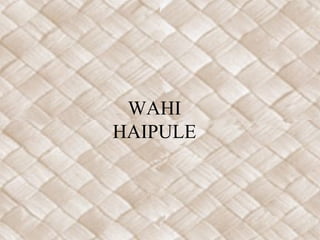
Wahi haipule
- 1. WAHI HAIPULE
- 2. WAHI HAIPULE • Wahi – n. Place, location, position, site, setting • Haipule – Religious, devout, pious, reverent; piety, a pious person; to worship; to hold prayers or service, as to consecrate a heiau
- 3. HEIAU • n. Pre-Christian place of worship, shrine; some heiau were elaborately constructed stone platforms, others simple earth terraces. Many are preserved today. – Ahu`ena – Mo`okini – Pu`ukoholā – Mailekini – Waha`ula
- 4. PARTS OF A HEIAU • Enclosure - paehumu, pā • Area within the enclosure – kahua • Altar - ahu, kuahu, lele • Tower - `anu`u
- 6. HEIAU MĀ PELE • n. Thatched heiau (temple) for the worship of Lono and the increase of food; the offerings were of pigs, not humans.
- 7. KŪ`ULA • n. Any stone god used to attract fish, whether tiny or enormous, carved or natural, named for the god of fishermen
- 8. KO`A
- 9. If you have any questions, please ask them on the Discussion Board. Mahalo!
Notas do Editor
- Large heiau that were dedicated to Kū Priests in this heiau inherited their positions and held rank and power Thus, the training was much more extensive The ceremonies that they presided over were complex and strict, often requiring elaborate preparation and precisely tendered offerings at one or more of three kinds of altar: po`okanaka for human sacrifices; smaller waihau where pigs were offered and unu where items like mai`a, niu and `awa were the usual offerings
- Belonged to the maka`āinana and were used principally for prayers and offers to Lono, beseeching him for adequate rainfall and good crops as well as giving thanks for harvests More common in dry leeward areas, where need for rain was a frequent concern and an important reason for prayers
- heiau near the sea for worship of fish gods; hut where fish gear was kept with kūʻula images so that gear might be impregnated with kūʻula mana, usually inland and very taboo. Lit., red Kū Kū`ula is the place for Kū`ula – the form of the god Kū who was a patron for dynamic fishery. Places of mana and reference that were built for the ocean fisherman – not shoreline fishing, but the kind that required you to go away from the shore int othe deep water zones. You would go to the kū`ula to gather your mana and then go out to the ko`a to fish
- n. Shrine, often consisting of circular piles of coral or stone, built along the shore or by ponds or streams, used in ceremonies as to make fish multiply; fishing grounds, usually identified by lining up with marks on shore. It’s an aggregate, so fish accumulate around that thing. Other fish come to eat them, and then you come over there to eat them, with the knowledge that you know how to catch them. The ko‘a is the object of the focus of the ku‘ula, the ko‘a being the fishery and the ku‘ula being the place for Ku‘ula, the form of the god Ku who was a patron for dynamic fishery. Fishermen sought protection during fishing trips and continued abundance of the fisheries through offerings of fish, urchins, and shell fish to the gods and ʻaumakua (guardians). Offerings would again be made upon return from fishing expeditions to thank the gods for their successful catch and safe return. Koʻa (fishing shrines) and heiau (sacred temples) are often composed of corals due to their ability to snare mana or spiritual energies from the ʻakua (gods) and surrounding environment. Hoʻokupu were placed among these sacred structures in the name of Kūʻula and Hinapukuiʻa to give praises and blessings for bountiful fish catches